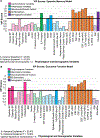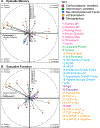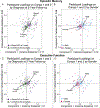Partial Least Squares Regression Analysis of Alzheimer's Disease Biomarkers, Modifiable Health Variables, and Cognitive Change in Older Adults with Mild Cognitive Impairment
- PMID: 37066909
- PMCID: PMC10999056
- DOI: 10.3233/JAD-221084
Partial Least Squares Regression Analysis of Alzheimer's Disease Biomarkers, Modifiable Health Variables, and Cognitive Change in Older Adults with Mild Cognitive Impairment
Abstract
Background: Prior work has shown that certain modifiable health, Alzheimer's disease (AD) biomarker, and demographic variables are associated with cognitive performance. However, less is known about the relative importance of these different domains of variables in predicting longitudinal change in cognition.
Objective: Identify novel relationships between modifiable physical and health variables, AD biomarkers, and slope of cognitive change over two years in a cohort of older adults with mild cognitive impairment (MCI).
Methods: Metrics of cardiometabolic risk, stress, inflammation, neurotrophic/growth factors, and AD pathology were assessed in 123 older adults with MCI at baseline from the Alzheimer's Disease Neuroimaging Initiative (mean age = 73.9; SD = 7.6; mean education = 16.0; SD = 3.0). Partial least squares regression (PLSR)-a multivariate method which creates components that best predict an outcome-was used to identify whether these physiological variables were important in predicting slope of change in episodic memory or executive function over two years.
Results: At two-year follow-up, the two PLSR models predicted, respectively, 20.0% and 19.6% of the variance in change in episodic memory and executive function. Baseline levels of AD biomarkers were important in predicting change in both episodic memory and executive function. Baseline education and neurotrophic/growth factors were important in predicting change in episodic memory, whereas cardiometabolic variables such as blood pressure and cholesterol were important in predicting change in executive function.
Conclusion: These data-driven analyses highlight the impact of AD biomarkers on cognitive change and further clarify potential domain specific relationships with predictors of cognitive change.
Keywords: Episodic memory; executive function; healthy aging; inflammation; metabolic syndrome; neuronal plasticity; neuroprotection; neuropsychology.
Conflict of interest statement
CONFLICT OF INTEREST
The authors do not have any conflicts of interest.
Figures



Comment in
-
Multifactorial Modeling of Cognitive Trajectories Using an Advanced Regression Technique: Improving Our Understanding of Biomarkers and Modifiable Variables that Support Cognition.J Alzheimers Dis. 2023;93(2):815-819. doi: 10.3233/JAD-230304. J Alzheimers Dis. 2023. PMID: 37212065
Similar articles
-
Partial Least Squares Analysis of Alzheimer's Disease Biomarkers, Modifiable Health Variables, and Cognition in Older Adults with Mild Cognitive Impairment.J Int Neuropsychol Soc. 2022 Sep;28(8):781-789. doi: 10.1017/S1355617721001041. Epub 2021 Oct 19. J Int Neuropsychol Soc. 2022. PMID: 34664547 Free PMC article.
-
Baseline cognition is the best predictor of 4-year cognitive change in cognitively intact older adults.Alzheimers Res Ther. 2021 Apr 7;13(1):75. doi: 10.1186/s13195-021-00798-4. Alzheimers Res Ther. 2021. PMID: 33827690 Free PMC article.
-
The role of vascular endothelial growth factor in neurodegeneration and cognitive decline: exploring interactions with biomarkers of Alzheimer disease.JAMA Neurol. 2015 May;72(5):520-9. doi: 10.1001/jamaneurol.2014.4761. JAMA Neurol. 2015. PMID: 25751166 Free PMC article.
-
Multifactorial Modeling of Cognitive Trajectories Using an Advanced Regression Technique: Improving Our Understanding of Biomarkers and Modifiable Variables that Support Cognition.J Alzheimers Dis. 2023;93(2):815-819. doi: 10.3233/JAD-230304. J Alzheimers Dis. 2023. PMID: 37212065
-
Changes in cognition.Neurobiol Aging. 2011 Dec;32 Suppl 1(0 1):S58-63. doi: 10.1016/j.neurobiolaging.2011.09.010. Neurobiol Aging. 2011. PMID: 22078174 Free PMC article. Review.
Cited by
-
Neuronal and glial dysfunction, white matter hyperintensities and cognition in ageing and Alzheimer's disease.Brain Commun. 2025 Feb 14;7(1):fcaf068. doi: 10.1093/braincomms/fcaf068. eCollection 2025. Brain Commun. 2025. PMID: 39995657 Free PMC article.
References
-
- Rios M (2014) For immediate release: Tuesday, May 06, 2014. Census.gov 2012–2014.
-
- Diniz BSO, Pinto JA, Forlenza OV (2008) Do CSF total tau, phosphorylated tau, and b-amyloid 42 help to predict progression of mild cognitive impairment to Alzheimer’s disease? A systematic review and meta-analysis of the literature. World J Biol Psychiatry 9, 172–182. - PubMed
-
- Hansson O, Seibyl J, Stomrud E, Zetterberg H, Trojanowski JQ, Bittner T, Lifke V, Corradini V, Eichenlaub U, Batrla R, Buck K, Zink K, Rabe C, Blennow K, Shaw LM (2018) CSF biomarkers of Alzheimer’s disease concord with amyloid-β PET and predict clinical progression: A study of fully automated immunoassays in BioFINDER and ADNI cohorts. Alzheimers Dement 14, 1470–1481. - PMC - PubMed
Publication types
MeSH terms
Substances
Grants and funding
LinkOut - more resources
Full Text Sources
Medical

